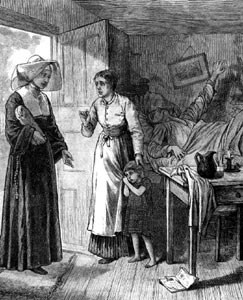
Yellow Fever Epidemics
Epidemic diseases caused great concern for nineteenth-century Tennesseans. Subject to outbreaks of cholera, smallpox, and dysentery, people lived with the stark reality of disease-induced death, especially in the growing urban areas where sanitation was often poor. For residents of West Tennessee, and particularly Memphis, yellow fever posed the greatest threat. The disease caused fevers, chills, hemorrhaging, severe pains, and sometimes a jaundicing of the skin, which gave yellow fever its name. The trademark of the disease, however, was the victim’s black vomit, composed of blood and stomach acids. Although its cause was unknown until 1900, yellow fever was transmitted from person to person by the female Aedes aegypti mosquito. Sailors on ships from the Caribbean or West Africa, from which the disease most likely originated, docked in New Orleans, where mosquitoes spread the disease from the infected person to the local population. River traffic carried yellow fever up the Mississippi Valley as long as mosquitoes were available to transmit the disease from human to human. Reprieve came only with the first frost.
Although Memphis had been exposed to yellow fever in 1828, 1855, and 1867, nothing prepared the city for the devastation the fever brought during the 1870s. An 1873 epidemic claimed 2,000 in Memphis, a number which constituted at the time the most yellow fever victims in an inland city. In 1878 a mild winter, a long spring, and a torrid summer produced favorable conditions for the breeding of Aedes aegypti and thus the spread of the fever. When New Orleans newspapers reported an epidemic in late July, Memphis officials established checkpoints at major points of entry into the city.
The efforts at quarantine were not extensive enough, though, and, in any event, most likely came too late. Yellow fever cases were probably developing on the fringes of Memphis as early as late July, and by August 13 the first death was reported in the city itself. With the horrors of the 1873 epidemic fresh on their minds, roughly 25,000 residents fled the city within two weeks. The fever raged in Memphis until mid-October, infecting over 17,000 and killing 5,150. Over 90 percent of whites who remained contracted yellow fever, and roughly 70 percent of these died. Long thought to be immune to the disease, blacks contracted the fever in large numbers as well in 1878, although only 7 percent of infected blacks died. While there is still no consensus among experts explaining this racial disparity in mortality rates, it is likely that repeated exposure to yellow fever over many generations in West Africa provided many blacks with a higher resistance to the disease.
Fleeing Memphians encountered quarantines throughout the South. Some of these, like the one at Jackson, Tennessee, were successful in keeping the disease from spreading. But like the attempts at quarantine in Memphis, most of these efforts were not thorough enough. Hardest hit were the Tennessee towns along the various railroads leading out of Memphis. Germantown, Moscow, Milan, Collierville, Paris, Brownsville, Martin, and LaGrange each experienced staggering losses relative to the size of their communities. Traveling along the Memphis and Charleston Railroad, the fever even spread to a swampy slum district of Chattanooga, causing 8,000 of the city’s residents to flee.
Long after cold weather brought relief from the fever, Memphis still felt the effects of the epidemic. Yellow fever exacerbated the already dismal financial situation in the city to the point that the legislature revoked the Memphis city charter in 1879. The fever also contributed to substantial declines in the Irish and German communities as well as the general population. Despite all the horrors, however, the impact of yellow fever on Memphis was not all negative. Leaders of the black community were able to use their numerical advantage during the fever to place blacks on the police force as patrolmen for the first time in the city’s history. Contrary to the prevailing trend in other southern cities where blacks disappeared from police forces soon after Reconstruction ended, blacks remained on the force in Memphis until 1895. Perhaps most importantly, after yellow fever visited the city once again in 1879, Memphis leaders embarked on ambitious sanitation reform. Although the fact that yellow fever did not strike the city in epidemic proportions again is less the product of sanitary reforms than of the immunity acquired by many in the Mid-South during 1878, the new sewer systems and better water supply did do wonders for public health as a whole, particularly in preventing outbreaks of cholera, dysentery, and other water-borne diseases.
Suggested Reading
Khaled J. Bloom, The Mississippi Valleys Great Yellow Fever Epidemic of 1878 (1993); Dennis C. Rousey, “Yellow Fever and Black Policemen in Memphis: A Post-Reconstruction Anomaly,” Journal of Southern History 51 (1985): 357-74; Lynette B. Wrenn, “The Impact of Yellow Fever on Memphis: A Reappraisal,” West Tennessee Historical Society Papers 41 (1987): 4-18



